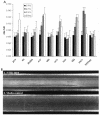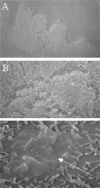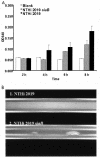Sialylation of lipooligosaccharides promotes biofilm formation by nontypeable Haemophilus influenzae
- PMID: 14688087
- PMCID: PMC343998
- DOI: 10.1128/IAI.72.1.106-113.2004
Sialylation of lipooligosaccharides promotes biofilm formation by nontypeable Haemophilus influenzae
Abstract
Nontypeable Haemophilus influenzae (NTHi) is a major cause of opportunistic respiratory tract infections, including otitis media and bronchitis. The persistence of NTHi in vivo is thought to involve bacterial persistence in a biofilm community. Therefore, there is a need for further definition of bacterial factors contributing to biofilm formation by NTHi. Like other bacteria inhabiting host mucosal surfaces, NTHi has on its surface a diverse array of lipooligosaccharides (LOS) that influence host-bacterial interactions. In this study, we show that LOS containing sialic (N-acetyl-neuraminic) acid promotes biofilm formation by NTHi in vitro and bacterial persistence within the middle ear or lung in vivo. LOS from NTHi in biofilms was sialylated, as determined by comparison of electrophoretic mobilities and immunochemical reactivities before and after neuraminidase treatment. Biofilm formation was significantly reduced in media lacking sialic acid, and a siaB (CMP-sialic acid synthetase) mutant was deficient in biofilm formation in three different in vitro model systems. The persistence of an asialylated siaB mutant was attenuated in a gerbil middle ear infection model system, as well as in a rat pulmonary challenge model system. These data show that sialylated LOS glycoforms promote biofilm formation by NTHi and persistence in vivo.
Figures





Similar articles
-
Phosphorylcholine decreases early inflammation and promotes the establishment of stable biofilm communities of nontypeable Haemophilus influenzae strain 86-028NP in a chinchilla model of otitis media.Infect Immun. 2007 Feb;75(2):958-65. doi: 10.1128/IAI.01691-06. Epub 2006 Nov 27. Infect Immun. 2007. PMID: 17130253 Free PMC article.
-
Phosphorylcholine expression by nontypeable Haemophilus influenzae correlates with maturation of biofilm communities in vitro and in vivo.J Bacteriol. 2007 Nov;189(22):8300-7. doi: 10.1128/JB.00532-07. Epub 2007 Jun 15. J Bacteriol. 2007. PMID: 17573475 Free PMC article.
-
LuxS promotes biofilm maturation and persistence of nontypeable haemophilus influenzae in vivo via modulation of lipooligosaccharides on the bacterial surface.Infect Immun. 2009 Sep;77(9):4081-91. doi: 10.1128/IAI.00320-09. Epub 2009 Jun 29. Infect Immun. 2009. PMID: 19564381 Free PMC article.
-
Nontypeable Haemophilus influenzae biofilms: role in chronic airway infections.Front Cell Infect Microbiol. 2012 Jul 25;2:97. doi: 10.3389/fcimb.2012.00097. eCollection 2012. Front Cell Infect Microbiol. 2012. PMID: 22919686 Free PMC article. Review.
-
Novel concepts in nontypeable Haemophilus influenzae biofilm formation.FEMS Microbiol Lett. 2013 Sep;346(2):81-9. doi: 10.1111/1574-6968.12203. Epub 2013 Jul 15. FEMS Microbiol Lett. 2013. PMID: 23808954 Review.
Cited by
-
Epidemic Trends and Biofilm Formation Mechanisms of Haemophilus influenzae: Insights into Clinical Implications and Prevention Strategies.Infect Drug Resist. 2023 Aug 16;16:5359-5373. doi: 10.2147/IDR.S424468. eCollection 2023. Infect Drug Resist. 2023. PMID: 37605758 Free PMC article. Review.
-
Genomic and metabolic profiling of nonulosonic acids in Vibrionaceae reveal biochemical phenotypes of allelic divergence in Vibrio vulnificus.Appl Environ Microbiol. 2011 Aug 15;77(16):5782-93. doi: 10.1128/AEM.00712-11. Epub 2011 Jul 1. Appl Environ Microbiol. 2011. PMID: 21724895 Free PMC article.
-
Lipooligosaccharides containing phosphorylcholine delay pulmonary clearance of nontypeable Haemophilus influenzae.Infect Immun. 2008 May;76(5):2037-43. doi: 10.1128/IAI.01716-07. Epub 2008 Mar 17. Infect Immun. 2008. PMID: 18347044 Free PMC article.
-
Biofilm formation by Moraxella catarrhalis in vitro: roles of the UspA1 adhesin and the Hag hemagglutinin.Infect Immun. 2006 Mar;74(3):1588-96. doi: 10.1128/IAI.74.3.1588-1596.2006. Infect Immun. 2006. PMID: 16495530 Free PMC article.
-
YdgG (TqsA) controls biofilm formation in Escherichia coli K-12 through autoinducer 2 transport.J Bacteriol. 2006 Jan;188(2):587-98. doi: 10.1128/JB.188.2.587-598.2006. J Bacteriol. 2006. PMID: 16385049 Free PMC article.
References
-
- Alder, J. D., P. J. Ewing, A. M. Nilius, M. Mitten, A. Tovcimak, A. Oleksijew, K. Jarvis, L. Paige, and S. K. T. Tanaka. 1998. Dynamics of clarithromycin and azithromycin efficacies against experimental Haemophilus influenzae pulmonary infection. Antimicrob. Agents Chemother. 42:2385-2390. - PMC - PubMed
-
- Bakaletz, L. O., T. M. Hoepf, T. F. DeMaria, and D. J. Lim. 1988. The effect of antecedent influenza A virus infection on the adherence of Hemophilus influenzae to chinchilla tracheal epithelium. Am. J. Otolaryngol. 9:127-134. - PubMed
-
- Bakaletz, L. O., B.-J. Kennedy, L. A. Novotny, G. Duquesne, J. Cohen, and Y. Lobet. 1999. Protection against development of otitis media induced by nontypeable Haemophilus influenzae by both active and passive immunization in a chinchilla model of virus-bacterium superinfection. Infect. Immun. 67:2746-2762. - PMC - PubMed
-
- Bauer, S. H., M. Mansson, D. W. Hood, J. C. Richards, E. R. Moxon, and E. K. Schweda. 2001. A rapid and sensitive procedure for determination of 5-N-acetyl neuraminic acid in lipopolysaccharides of Haemophilus influenzae: a survey of 24 non-typeable H. influenzae strains. Carbohydr. Res. 335:251-260. - PubMed
-
- Bouchet, V., D. W. Hood, J. Li, J. R. Brisson, G. A. Randle, A. Martin, Z. Li, R. Goldstein, E. K. Schweda, S. I. Pelton, J. C. Richards, and E. R. Moxon. 2003. Host-derived sialic acid is incorporated into Haemophilus influenzae lipopolysaccharide and is a major virulence factor in experimental otitis media. Proc. Natl. Acad. Sci. USA 100:8898-8903. - PMC - PubMed
Publication types
MeSH terms
Substances
Grants and funding
LinkOut - more resources
Full Text Sources
Other Literature Sources

